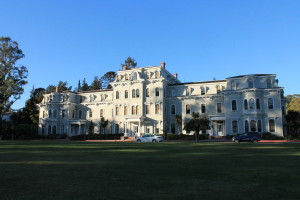On Oct. 4, the Drought Committee met to discuss water conservation at Mills, and ways that the school could improve.
Mills has been seeking to conserve water even before water restrictions made by Governor Jerry Brown were announced. It currently uses about 18 million gallons per year, down from 28 million gallons per year when the drought started. The school would like to use 25 percent less water than the 28 million gallons used pre-drought. So far, the campus uses recycled rainwater toilets in the Lokey Graduate School of Business (GSB) as well as the Moore Natural Sciences Building (NSB), and planted native drought resistant grass in front of GSB.

California is in its sixth year of the worst drought in over a century. Two years ago, the California Water Board mandated new guidelines for ensuring that California uses less water than it has been, including banning the use of water as a decorative feature, requiring hoses to have shut-off valves, and prohibiting watering outdoor landscapes.
Nicole Gaetjens, sustainability coordinator, is trying to figure out ways to further improve water use at Mills. She thinks the pool and the lawns on campus could be improved.
“Granted, you can’t reduce all that water because people need to take showers and cook things, but I know the pool especially has been using more water than we initially thought,” Gaetjens said, referring to the 1 million gallons the pool uses yearly.
Gaetjens and Mike McBride, chief engineer at Mills, had gone to the pool with PG&E to discuss putting a mechanical cover on the pool, which would give them a discount in addition to reducing water loss.
Meanwhile, the lawns have different needs in regards to water conservation. The word “lawn” is used for any area of grass, from Holmgren Meadow, to the President’s Meadow, to the courtyard of NSB, to the “dog lawn” by the Commuter and Guest Parking Lot. To further increase sustainability, Mills is discussing how to transition from using (filtered and drinkable) potable water, to (not drinkable and straight from the source) non-potable water on the Courtyard Townhouse Apartment lawns, the NSB courtyard lawn, the lawn between Ethel Moore and Mary Morse, and the Trefethen pool lawn.
All the other lawns on campus are “all lake,” says Ron Galvin, grounds manager at Mills, meaning that the water used on those lawns comes from Lake Aliso, behind Founder’s Dining Hall.
The biggest source of water waste by far at Mills is the leaks. Leaks account for five million gallons per year out of the 18 million gallons the entire school uses. These leaks occur mainly in the pipes underground, but can also occur in sink faucets.
According to McBride, the school could use a leak detecting company, which they have in the past. Previously, the company needed to cut off the pipe at both ends. That entailed cutting off water to nearby buildings.
In addition, McBride also knew the general area of the main pipe leak and was sure it was still continuing . The largest obstacle to finding leaks is that the main water line at Mills is not made of metal, making it harder to detect.
“The only way we find out if they’re underground leaks is if it surfaces. Generally they do surface since none of our pipes are generally deep [….] Finding those leaks is a hard, hard, task,” McBride said.
On the other hand, McBride believes that the faucet leaks in the dorms and elsewhere are not too much of a problem, because the students are good with work orders.
The Drought Committee meets once a month. Announcements of meetings are posted in the Student Forum Newsletter. Students can reduce water wastage and improve sustainability by submitting a work order if leaks appear, and by joining a Creek Care Day every Friday.




